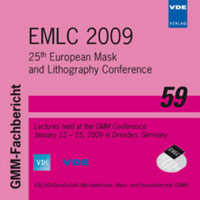Deflection Unit for Multi-Beam Mask Making
Conference: EMLC 2009 - 25th European Mask and Lithography Conference
01/12/2009 - 01/15/2009 at Dresden, Germany
Proceedings: EMLC 2009
Pages: 12Language: englishTyp: PDF
Personal VDE Members are entitled to a 10% discount on this title
Authors:
Letzkus, Florian; Butschke, Joerg; Irmscher, Mathias; Jurisch, Michael; Klingler, Wolfram (IMS Chips, Allmandring 30a, D-70569 Stuttgart, Germany)
Platzgummer, Elmar; Klein, Christof; Loeschner, Hans; Springer, Reinhard (IMS Nanofabrication AG, Schreygasse 3, A-1020 Vienna, Austria)
Abstract:
Two main challenges of future mask making are the decreasing throughput of the pattern generators and the insufficient line edge roughness of the resist structures. The increasing design complexity with smaller feature sizes combined with additional pattern elements of the Optical Proximity Correction generates huge data volumes which reduce correspondingly the throughput of conventional single e-beam pattern generators. On the other hand the achievable line edge roughness when using sensitive chemically amplified resists does not fulfill the future requirements. The application of less sensitive resists may provide an improved roughness, however on account of throughput, as well. To overcome this challenge a proton multi-beam pattern generator is developed [1]. Starting with a highly parallel broad beam, an aperture-plate is used to generate thousands of separate spot beams. These beams pass through a blanking-plate unit, based on a CMOS device for de-multiplexing the writing data and equipped with electrodes placed around the apertures switching the beams “on” or “off”, dependent on the desired pattern. The beam array is demagnified by a 200x reduction optics and the exposure of the entire substrate is done by a continuous moving stage. One major challenge is the fabrication of the required high aspect deflection electrodes and their connection to the CMOS device. One approach is to combine a post-processed CMOS chip with a MEMS component containing the deflection electrodes and to realize the electrical connection of both by vertical integration techniques. For the evaluation and assessment of this considered scheme and fabrication technique, a proof-of-concept deflection unit has been realized and tested. Our design is based on the generation of the deflection electrodes in a silicon membrane by etching trenches and oxide filling afterwards. In a 5mm x 5mm area 43,000 apertures with the corresponding electrodes have been structured and wired individually or in groups with aluminum lines. The aperture-plate for shaping the beams has been aligned and mounted on top of the blanking-plate. Afterwards this sandwich has been fixed on a base-plate with a pin plug as interface. The electrical connection has been performed with a standard chip bonding process to the aluminum pads on the blanking-plate. Finally, the proof-of-concept deflection unit was evaluated in a test bench. The results of electrical- and exposure tests are presented and discussed in detail.


